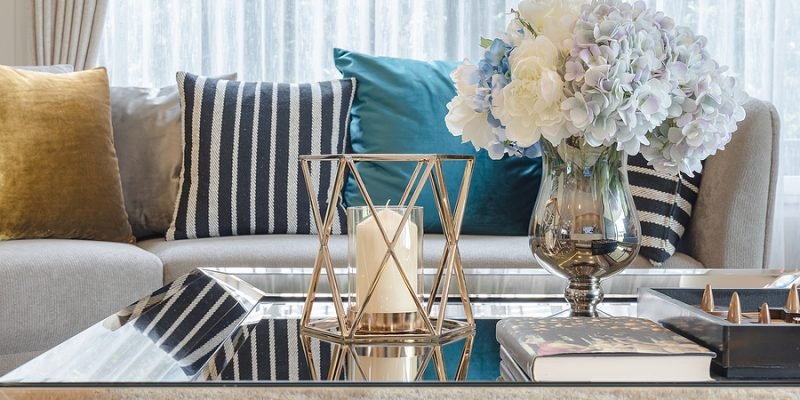Decorative pillows are one of the easiest and most effective ways to refresh a room’s decor. They add color, texture, and personality, transforming your bed, sofa, or chairs into a styled space. However, arranging decorative pillows can sometimes feel like a daunting task. How many pillows are too many? Which sizes and shapes work best together? How do you mix patterns and colors without clashing? In this guide, we’ll explore the art of arranging decorative pillows to help you create a beautiful, balanced look in any room.
1. Start with a Base
When arranging decorative pillows, it’s essential to start with a base. This typically involves choosing the largest pillows that will form the foundation of your arrangement. For a sofa, these are often square pillows, while for a bed, they might be larger Euro pillows.
- Size: On a sofa, start with 20-24 inch pillows for a balanced look. For a bed, Euro pillows (26×26 inches) are a great base behind standard shams.
- Solid Colors or Subtle Patterns: The base pillows are often in solid colors or subtle patterns that complement the overall color scheme of the room. This creates a cohesive backdrop for the smaller, more detailed pillows.
2. Layer in Medium-Sized Pillows
Once you have your base, it’s time to layer in medium-sized pillows. These pillows are typically smaller than the base pillows and can introduce more color, pattern, or texture into the arrangement.

- Mixing Patterns: When mixing patterns, aim for variety while maintaining harmony. A good rule of thumb is to mix one solid, one busy pattern (like florals or geometrics), and one simple pattern (like stripes or polka dots).
- Contrasting Colors: Introduce pillows in a contrasting color to make the arrangement pop. For example, if your base pillows are neutral, add medium-sized pillows in a bold or accent color that ties into other elements of the room.
3. Add Accent Pillows
Accent pillows are the smallest in the arrangement, but they pack a big punch in terms of style. These pillows can have bold patterns, intricate details, or unique shapes that draw the eye and add interest to the arrangement.
- Unique Shapes: Consider adding a lumbar pillow, round pillow, or even a novelty-shaped pillow as an accent. These pillows break up the symmetry and add a dynamic element to the arrangement.
- Details and Texture: Look for accent pillows with interesting textures, like velvet, embroidery, or fringe. These details add depth and dimension to the overall look.
4. Consider Symmetry and Balance
While there are no hard and fast rules when it comes to pillow arrangements, symmetry often creates a more balanced and visually pleasing look, especially on a sofa or bed.
- Even Numbers: For a more traditional or formal look, use an even number of pillows arranged symmetrically. For example, two larger pillows on either side of a sofa, followed by two smaller pillows and a central accent pillow.
- Odd Numbers: For a more relaxed, modern feel, opt for an odd number of pillows. This creates a slightly asymmetrical look that feels casual yet stylish.
5. Think About Proportion
Proportion is key to a well-styled pillow arrangement. Pay attention to the size of your furniture and choose pillows that are proportional to the piece they’re placed on.
- Large Furniture: If you have a large sofa or bed, go for larger pillows that match the scale of the furniture. Small pillows on a large sofa can look lost, while oversized pillows on a small chair can overwhelm the space.
- Small Furniture: On smaller furniture, such as accent chairs or a love seat, use fewer and smaller pillows to avoid clutter. A single lumbar pillow or a pair of 18-inch pillows might be all you need.
6. Experiment with Arrangements
One of the fun parts of decorating with pillows is the ability to experiment with different arrangements until you find the one that feels just right.
- Layered Look: Try layering different sizes and shapes, starting with the largest pillows at the back and working your way forward. This creates a sense of depth and richness.
- Central Focus: For a bed, consider placing a single, striking accent pillow at the center, flanked by smaller pillows on either side. This draws the eye to the middle of the bed and creates a focal point.
7. Seasonal Swaps
Pillows are an easy and cost-effective way to change up your decor with the seasons. Keep a collection of pillow covers in different colors, patterns, and textures, and swap them out as the seasons change.
- Spring and Summer: Opt for lighter fabrics like linen or cotton in bright, cheerful colors or floral patterns.
- Fall and Winter: Choose richer fabrics like velvet or wool in deep, warm tones. Patterns like plaids or cozy textures like knits can add a seasonal touch.
8. Don’t Overdo It
While decorative pillows are great, it’s easy to go overboard. Too many pillows can make your furniture look cluttered and less functional.
- Sofa: Depending on the size of your sofa, 5-7 pillows are usually enough to create a well-balanced look. Ensure there’s enough space to sit comfortably.
- Bed: On a bed, try to keep the arrangement to 3-6 pillows, depending on the size of the bed. You want the pillows to enhance the look, not overpower it.
By mastering the art of arranging decorative pillows, you can easily elevate the style and comfort of any room. Whether you prefer a symmetrical look or a more eclectic arrangement, these tips will help you create a polished, inviting space. So, grab your favorite pillows and start styling!
